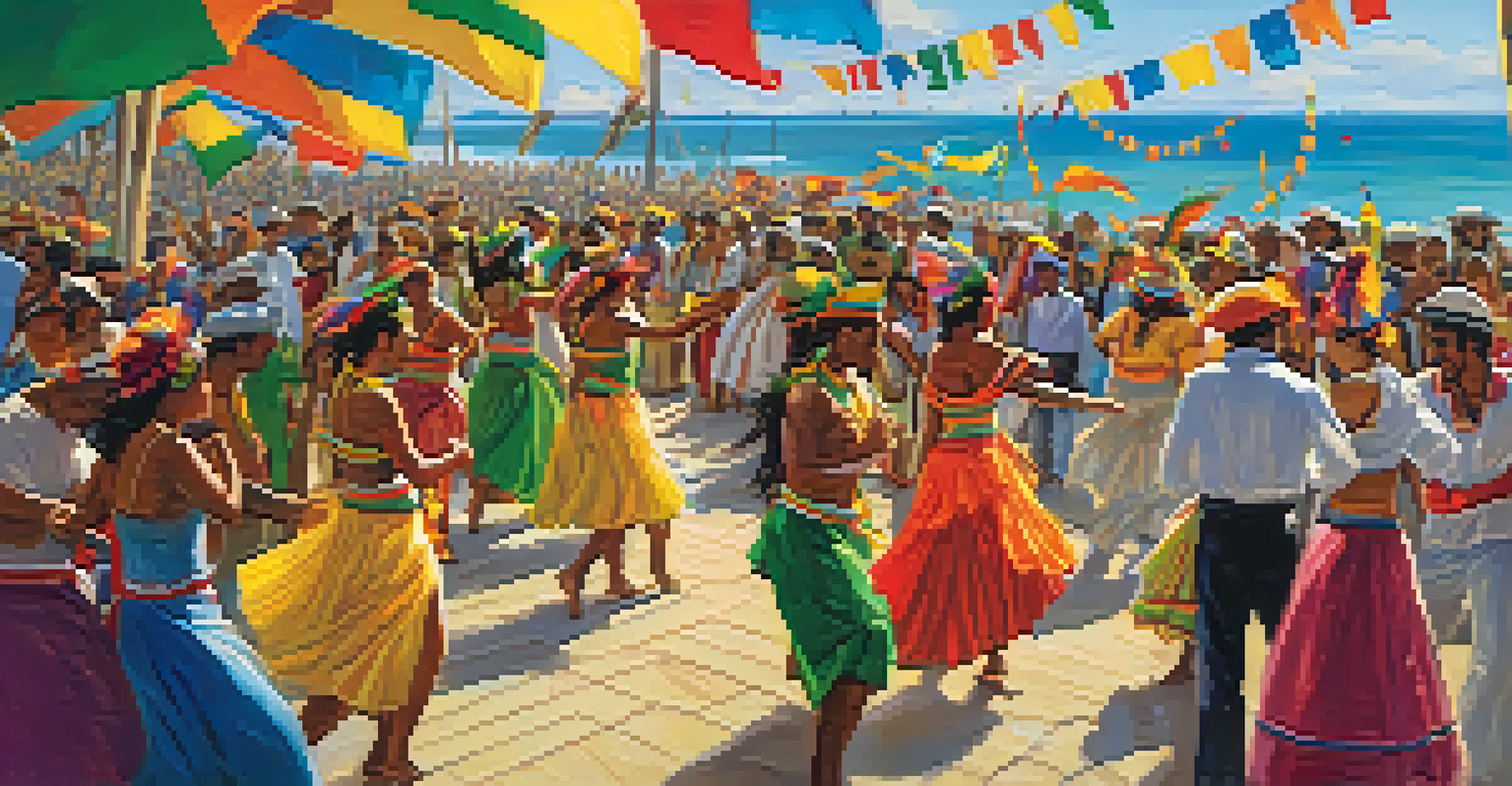From Coast to Coast: Brazil's Historical Maritime Trails

The Origins of Brazil's Maritime Heritage
Brazil's maritime history begins long before the arrival of Europeans. Indigenous peoples navigated its vast rivers and coastal areas, using canoes and other traditional boats for fishing and trade. Their understanding of the waters laid the groundwork for the country's future maritime endeavors.
The sea, once it casts its spell, holds one in its net of wonder forever.
With the arrival of Portuguese explorers in the 1500s, Brazil's coastlines became bustling hubs of commerce. The Portuguese established shipping routes that connected Brazil to Europe, leading to the export of valuable resources like sugar and gold. This era marked the beginning of Brazil's transformation into a key player in global trade.
As Brazil developed, so did its maritime infrastructure. Ports like Salvador and Rio de Janeiro emerged as vital centers for trade and cultural exchange. These developments would shape not only Brazil's economy but also its identity as a nation with a rich seafaring tradition.
The Age of Exploration and Its Impact
The Age of Exploration was a pivotal time for Brazil, as European powers raced to discover new lands and resources. Explorers like Vasco da Gama and Ferdinand Magellan played crucial roles in mapping the Brazilian coastline. Their voyages opened up new opportunities for trade and colonization.

These explorations led to the establishment of various settlements along the coast, each contributing to Brazil's diverse cultural tapestry. The blending of indigenous, African, and European influences created a unique maritime culture that persists today. This cultural fusion is evident in Brazilian cuisine, music, and festivals.
Brazil's Rich Maritime History
Brazil's maritime heritage is deeply rooted in its indigenous navigation practices, European exploration, and the establishment of trade routes.
Additionally, the Age of Exploration paved the way for the development of Brazil's shipping industry. The rise of merchant ships facilitated the transportation of goods, allowing for the growth of cities and the expansion of trade networks. This period solidified Brazil's position on the world stage as a maritime nation.
The Role of Slavery in Maritime Trade
One of the darker chapters in Brazil's maritime history is the transatlantic slave trade. Between the 16th and 19th centuries, millions of African people were forcibly brought to Brazil to work on plantations and in mines. Their labor was crucial to the country's economic growth, especially in sugar and coffee production.
In every outthrust headland, in every curving bay, in every grain of sand there is the story of the earth.
The ports became key entry points for enslaved Africans, who were often transported under harrowing conditions. This painful history has left a profound impact on Brazilian society, influencing its demographics, culture, and social dynamics. The legacy of slavery is a reminder of the human cost behind Brazil's maritime prosperity.
Today, Brazil grapples with this legacy, as many communities strive to honor their ancestors' experiences. Initiatives to recognize and celebrate Afro-Brazilian culture are prevalent, showcasing the resilience and contributions of those who endured centuries of oppression. This acknowledgment is essential in understanding the full scope of Brazil's maritime history.
The Golden Age of Brazilian Shipping
The 19th century marked the Golden Age of Brazilian shipping, driven by the booming coffee trade. With advancements in shipbuilding and navigation, Brazilian merchants began to establish a more robust maritime presence. This period saw Brazilian ships sailing to Europe and North America, exporting coffee and other goods.
The growth of the shipping industry also led to the establishment of maritime institutions and associations, which fostered innovation and collaboration among seafarers. These organizations played a significant role in training future generations of sailors and promoting maritime safety and efficiency.
Cultural Impact of Maritime Trade
The blending of indigenous, African, and European influences during the Age of Exploration has shaped Brazil's diverse cultural identity.
As a result, Brazil became known for its skilled sailors and thriving ports, further cementing its reputation as a maritime power. This era was not only about commerce but also cultural exchange, as sailors brought back new ideas, technologies, and influences from around the world.
Brazil's Naval History and Military Influence
Brazil's naval history is rich and complex, reflecting its strategic importance in South America. The Brazilian Navy was established in the early 19th century, primarily to protect its coastal waters and trade routes. Over time, the Navy evolved into a formidable force, playing a crucial role in regional conflicts and international relations.
During the 19th and 20th centuries, Brazil's Navy participated in various military engagements, including World War II. The country's naval forces were instrumental in securing maritime trade routes and supporting Allied operations. This involvement showcased Brazil's growing influence on the global stage and solidified its position as a key player in maritime affairs.
Today, the Brazilian Navy continues to evolve, focusing on modernizing its fleet and addressing contemporary maritime challenges. Issues such as piracy, environmental protection, and resource management are at the forefront of its mission. This ongoing commitment reflects Brazil's recognition of the importance of safeguarding its maritime heritage.
Cultural Expressions of Maritime Heritage
Brazil's maritime history is not just found in its ports and ships; it resonates through its vibrant culture. From music to dance, the sea has inspired countless artistic expressions. For instance, the rhythms of samba and maracatu are deeply connected to coastal life and the experiences of those who lived by the sea.
Festivals like the Festa do Mar celebrate Brazil's maritime heritage, bringing communities together to honor their connections to the ocean. These events often feature traditional music, dance, and culinary delights, showcasing the rich cultural tapestry woven from Brazil's maritime past. They serve as a reminder of the enduring relationship between people and the sea.
Preserving Maritime Heritage
Efforts to safeguard Brazil's maritime history are essential for maintaining cultural identity and fostering community engagement with the ocean.
Additionally, literature and visual arts have drawn inspiration from the maritime landscape. Writers and artists often explore themes of adventure, longing, and the beauty of the ocean, reflecting the deep emotional ties that Brazilians have with their coastal environment. This cultural expression keeps the spirit of Brazil's maritime history alive for future generations.
Preserving Brazil's Maritime Heritage for the Future
As we look to the future, preserving Brazil's maritime heritage is essential for maintaining its cultural identity. Efforts are underway to safeguard historical sites, such as colonial-era ports and shipwrecks, which serve as tangible connections to the past. These sites offer valuable insights into Brazil's maritime history and its broader implications for society.
Education plays a crucial role in this preservation effort. Schools and organizations are increasingly incorporating maritime history into their curricula, ensuring that younger generations understand the significance of their coastal heritage. By fostering a sense of pride and responsibility, Brazil can cultivate a deeper appreciation for its maritime roots.

Community engagement is also vital in preserving this heritage. Local initiatives often promote responsible tourism and environmental stewardship, encouraging people to connect with the ocean while respecting its resources. By working together, Brazilians can ensure that their rich maritime history continues to thrive in an ever-changing world.